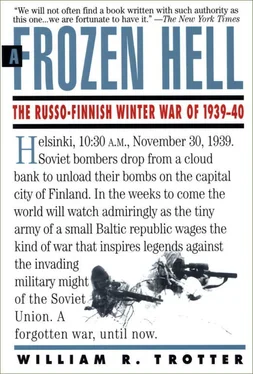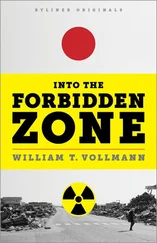But only on paper. As confined as the Karelian Isthmus is, it still offers much better terrain for a modern army than anything north of Lake Ladoga. Up there in the narrower part of Finland the forests are more dense, more primitive than words, maps, or even pictures can convey. Roads there were little better than one-lane wagon tracks, and those were often many miles apart. There was no shelter except for a few scattered farms and logging towns, set in clearings hacked out of the trees. Lateral passage between the roads was possible only for trained men on skis; men on foot could scarcely make any progress at all in midwinter, for the snowdrifts that pile up between the trees are tall enough to bury a man in a standing position.
Once committed to these regions, the invading columns would be hopelessly road bound. No matter how strong they were, a defender made mobile by skis could dance circles around them. What the Russians should have done in these areas was to infiltrate small units of ski guerrillas, which might well have slipped undetected through the forest and worked great damage in the more populated interior. But instead of small, mobile, specialist units, the Russians committed elephantine masses of conventional infantry and armor, which had no choice except to crawl westward along whatever roads they could find. The results of this strategic blundering were some of the most one-sided defeats ever inflicted on Russian troops.
At the start of hostilities, Russian forces were positioned as follows:
1. Seventh Army: On the Karelian Isthmus, under Meretskov; comprised of between twelve and fourteen divisions, with three tank brigades and a mechanized corps attached (1,000 tanks and other vehicles); its artillery strength was much augmented, even at the start; several divisions were still in the process of forming up when hostilities began; the objective was Viipuri, the breaching of the Mannerheim Line, and, ultimately, a sweep westward to Helsinki. Later on, for purposes of better operational control, this force was divided into the Seventh and Thirteenth armies.
2. Eighth Army: North of Lake Ladoga, in Ladoga-Karelia, facing the Finnish Fourth Corps under General Hägglund; composed of six rifle divisions and two tank brigades. Its mission was to turn the northern flank of the Isthmus defenses by circling around Lake Ladoga’s north shore, breaking through the relatively thin Finnish lines there, and striking south, to take the Mannerheim Line from the rear. The strength the Russians managed to deploy here was considerably more than the Finns had thought possible and was one of the nastier surprises of the war for them.
3. Ninth Army: Five rifle divisions with a motley and not well documented assortment of attached armored units. This army’s mission was to thrust westward, to reach as many centers of communication as possible, and to cut Finland in half if it could. Each of these divisions, however, went in unsupported, on poor and widely separated roads, with results that ranged from disappointing to disastrous.
4. Fourteenth Army: Three mediocre divisions with attached armor, based in Murmansk, intended to capture the arctic port of Petsamo and, eventually, the Lapland capital of Rovaniemi, which was Finland’s only significant center of communications in the far north.
The overall concept of the Russian plan was simple: push the Finns as hard as possible from eight different directions, by means of a coordinated westward advance. The Mannerheim Line would be hammered from the front by the Seventh Army and taken in the rear by the Eighth Army, while the Ninth Army would cut Finland in two and sever its communications with Sweden. In the far north, the Fourteenth Army would prevent any help from reaching Finland through Petsamo. It must be said that if the Russians had planned their offensive carefully, and if their troops had been better prepared for the tasks assigned to them, the plan might have worked.
The strategy Mannerheim and his staff had devised for Finland was predicated on some very harsh realities. Obviously Russia was the only likely opponent, and it was a delusion to think that Finland could successfully defend itself against the Red Army for an indefinite period of time. In the long run, Finland’s only real guarantee of continued existence was the conscience of Western civilization. Finland, it was hoped, would be regarded as a vital outpost of everything the Western powers stood for, and as such the country would not be allowed to vanish from the map. Thus was born a strategy designed to enable Finland to hang on long enough for outside aid to reach it. If that hope proved chimerical, the only thing left to do was to resist so fiercely that Stalin would opt for a negotiated settlement rather than total conquest. If Stalin did seek total subjugation, the Finns would fight to the last man and bullet. Mannerheim’s plans, therefore, were not based on the absurd hope of outright victory, but on “the most honorable annihilation, with the faint hope that the conscience of mankind would find an alternative solution as a reward for bravery and singleness of purpose.” [3] Langdon-Davies, John, Invasion in the Snow (Boston: Houghton Mifflin Co., 1941), 7.
Russia’s initial invasion force, already vastly superior in numbers and equipment, could of course draw on a virtually limitless reservoir of replacements, whereas Finland’s army would be fully extended almost from the start. Foreign military attachés in Helsinki believed that the Finns would fight stoutly, but in the face of the on-paper odds, most of them wrote off Finnish resistance as a heroic gesture that could not possibly stave off defeat for longer than a week or two.
The average Finnish soldier looked at matters much differently. He knew, in his bones, that on a man-to-man basis he was worth several of his opponents. His ancestors, as far back as recorded Finnish history existed, had fought Russians on this same soil and usually won. The Finn knew what he was fighting for and why. His stereotyped view of the Russian soldier was not flattering: Ivan was stupid, lazy, dirty, incapable of initiative, and mentally oppressed by the same forest environment that was second nature to the Finns. To be sure, the Finnish soldier was aware of the numerical odds against him, but he rendered those odds less terrible by cracking jokes about them: “They are so many, and our country is so small, where will we find room to bury them all?”
Most Finnish units were made up of men from the same geographical regions. Some of these units found themselves in action literally on their home ground, but nearly everyone fought on terrain very similar to the land he had known since childhood. Company-, platoon-, and battalion-level officers were usually well known to their men from peacetime and were often addressed by their first names or nicknames during combat. There was probably less saluting and less parade-ground spit and polish than in any other army in Europe. Finnish troops knew they were in the army to fight, not to march in parades, and in the kind of war they were called upon to fight, that was precisely the right set of priorities.
Before 1918, of course, there was formally no such thing as “the Finnish Army”—Finnish nationals gained experience in the tsar’s service and, during the years immediately preceding independence, the army of Imperial Germany. Both of those nations maintained conventional armies of the type most European nations supported in the years before World War I. The Finns serving in them would have received training designed to prepare a soldier to function in a large, carefully structured organization, whose combat arms were backed by a full array of service and support elements. Operating procedures in such armies were formalized by many years of historical tradition; things were done, in short, “by the book.”
Читать дальше












